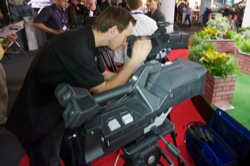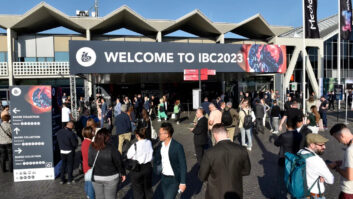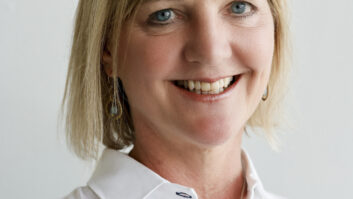
TVBEurope’s team of editors and journalists scoured all thirteen halls of this year’s exhibition to come up with the shortlist for this year’s Best of IBC Awards, before Associate Editor David Fox distilled the list down to the final selection. We start with Acquisition.
But first, a quick note from the Editor: Through the combination of TVBEurope and The IBC Daily personnel we have by far the largest editorial team on the ground at IBC each year. Our Editors are attuned to the European market, as they cover its news every week and every month – not just once a year off a plane from New York or Kansas. Our Best of IBC selections are just that – new products and innovations picked out as the smartest, most game-changing and most valuable to be launched at the show. We don’t have a prior agenda; we don’t just select advertisers; and our Best of IBC2010 Editors’ Awards are not pay-offs or favours.
We don’t shout about them too much, nor create hype about presenting plaques to exhibitors at the show – because we’re too busy reporting the event! All of our editors and writers make selections at the show and then the list is ‘stress-tested’ by Associate Editor David Fox who goes to see each candidate in person to ensure they qualify and are genuine. We believe that TVBEurope’s Best of IBC2010 Editors’ Awards really are objective, neutral, relevant and European!
– Fergal Ringrose
3D One – 3D camera
The first integrated 3D camcorder to start shipping; it has twin lenses and twin viewfinders, and has been designed to prevent users from shooting bad 3D. Not only will it not go out of alignment but users cannot shoot negative parallax as it’s a completely parallel system. “This is the most foolproof 3D camera that there is. You set it down, you press record, you stop, and you have your file recorded properly,” said Marcelo Ackermann, development and marketing support, 3D One.
www.3d-one.com
Arri – Alexa Plus and 3D upgrade
The Alexa Plus has a new side panel allowing integrated lens control (plus a new LDS lens mount), remote control and second monitor output. Available in January as an upgrade, it offers full remote control from an iPad, or any web browser, via WiFi. The camera can now output Arri Raw, supports all five Apple ProRes codecs, and offers increased dynamic range of 14 stops (available from 160 to 1,600 ISO rather than just at base sensitivity). A forthcoming upgrade (already in use on three movies) enables master/slave operation, synch sensor and synch output for 3D.
www.arri.com
Canon – XF105
This is a small camera with the electronics and controls of a bigger model (the XF305). It sacrifices the three sensors for one, to give a smaller form factor. That makes it interesting, but it is what it does with its Optical Image Stabilisation system in 3D mode that makes it innovative. The OIS can be used as an optical axis shift system to align the centre point of the lenses and the two cameras can be genlocked together, while additional assistance functions making it easier to set up for 3D.
www.canon-europe.com/tv-products/
Canon – XF300/XF305
These are the most affordable cameras on the BBC’s list of approved cameras for HD production (they are permitted for independent productions). They are Canon’s first Full HD MPEG-2 4:2:2 50Mbps camcorders, recording MXF files to Compact Flash cards, have three 1/3-inch CMOS sensors using high-speed data readout (2x) to minimise rolling shutter effects, and offer slow and fast motion recording.
www.canon-europe.com/tv-products/
Fujinon – 3D lenses
The five zoom lenses in its range should make 3D lens set up and synchronisation easier because they are matched pairs, with a new Synchronous Control System. “3D shooting is relatively complicated and you have to make sure the left and right eye get the same information, but if you use normal 2D zoom lenses you can get centering problems,” explained Andreas Adler (pictured), Fujinon Europe’s general manager, optical division. Therefore the new lenses had to have very accurate centering and adjustments that stay stable as you zoom. The new synchronous zoom and focus control box, is on its third version following tester feedback. It continually receives data from the lenses to check they are both in the same position as they are zoomed and makes any corrections necessary.
www.fujinon.de
Frontniche – VC-3100 HD
This Ortho-Stereoscopic camera manufactured by V3i looks just like a sleek version of a conventional OB camera, but with twin 18xlenses and two sets of 2/3-inch 3CCD sensors. It removes the need for a convergence operator. According to Frontniche’s Louise Bone (pictured) it boasts a “maximum 3D effect distance” of 360m, useful for sports, no 3D distortion (keystone or geometric), no rolling or vertical misalignment, and adjustable/automatic separation distance between lenses for 3D depth effect.
www.frontniche.com
Hego – OB1
This camera system captures six viewpoints simultaneously from one position. The viewpoints can be stitched together into a panorama or used as the basis of a virtual camera system that can be moved within the image, using the software that comes with the camera. It is aimed at use for sports, particularly for webcasting, and would allow one operator to produce what looks like a multi-camera production, with graphics and replays.
www.ob1.hegogroup.com
Imec – iVC
The imec Virtual Camera takes live feeds from at least two cameras at once to create a new viewing angle or even create 3D video. “Our aim is to make use of small IP cameras, which may for instance be plugged in at fixed positions in a soccer stadium. The installation of about 30 small cameras can show you images of the whole soccer field. For example, if you would like to have a camera image taken from the centre spot, this will be possible without having to install a real physical camera at this spot,” explained Johan De Geyter, manager of the imec Vision Technology group.
www.imec.be/ivc
IndieCam – 3D camera system
This uses tiny 1080p 50/60 cameras that can output 10-bit RAW (Adobe Cinema DNG) video, and can give an interaxial distance of just 40mm (depending on the size of the C-mount lenses used). IndieCam is developing its own Shuttle recorder/controller (available by NAB), but users can also use other HD-SDI recorders (with a remote control coming next month). Camera aids include histograms or zebra stripes, and it can create anaglyph previews on its 7-inch LCD monitor. The full system is expected to cost less than €40,000, although the camera heads are available now (50 have been made so far), and the system has been used on a few projects, including one shoot with 12 3D rigs.
www.indiecam.com
Panasonic – AF100/AF101 camera
The AG-AF101 will be the first professional camcorder using a DSLR-sized sensor, giving shallow depth of field and the ability to use a whole host of cine and stills lenses. It may only record AVCHD at 24Mbps on its SD cards, but with HD-SDI and HDMI output it can record at higher bitrates to external recorders. It will be available at the end of the year for €4,900.
www.panasonic-broadcast.com
Panasonic – HPX-3100 wireless camera control system
This new 2/3-inch ENG P2 camera uses WiFi to allow other users to view proxy video and to add metadata. It can use a standard web browser, so up to three people, such as the director, continuity or logger, can access it at once using their laptop, iPad or mobile phone. The €32,500 mid-range camcorder replaces the HPX-3000, and is smaller and lighter. “We’ve adopted the .mov format for the proxies, so they are easier to handle than MP4, and we haven’t forgotten the audio, which is now AAC or uncompressed 16-bit 48kHz [up from 24kHz on the 3000], so that an editor can do a complete audio edit on the proxies and not have to redo anything for the full resolution video,” explained Jerome Berrard, director AV Systems, Panasonic Europe (pictured).
www.panasonic-broadcast.com
Polecam – HRO 69
This ultra-compact 3.5mm lens is designed for miniature 3CCD HD cameras and is Polecam’s first lens. “Miniature split head cameras have become standard tools for HD video production in recent years, but traditional lens manufacturers have not responded to demand for matching high-quality optics,” said Polecam founder and MD Steffan Hewitt (pictured). He claimed it “produces far higher resolution images than any comparable model” and also costs considerably less.
www.polecam.com







